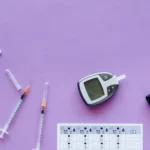Stroke in Diabetes patients is considered one of the macrovascular complications, just like a myocardial infarction (heart attack).
Your likelihood of suffering a stroke rises if you have diabetes. It is estimated that the prevalence of stroke in individuals with prediabetes and diabetes is 7.8% and 11.2%, respectively [Ref].
In one study, the prevalence of stroke in diabetics was 11.6% vs 5.1% in non-diabetics.
Your chance of ever having a stroke will be reduced by knowing your risk factors, adopting a healthy lifestyle, maintaining strict blood glucose (blood sugar) management, and more.
Stroke Prevalence: | Diabetics | Non-Diabetics |
| Prevalence of Stroke | 11.6% | 5.1% |
| The relative risk of stroke | Women: 1.40 Men: 1.70 | 1 |
| Stroke in patients with Diabetes + Hypertension | 17.8% | 8.9% |
What Does Having a Stroke Mean?
A stroke happens when the blood supply is suddenly cut off to a section of your brain. After that, the brain tissue is damaged.
The major reason for strokes is when a blood clot in the brain or neck blocks a blood vessel. However, stroke can also be hemorrhagic.
Hemorrhagic stroke occurs when blood starts leaking out from a blood vessel into the brain parenchyma.
Most hemorrhagic strokes or intracranial bleeds occur in patients with uncontrolled hypertension and those who are on blood thinners and anticoagulants.
All strokes present with one or more of the following symptoms:
- Limb weakness
- Asymmetry of the face
- Problems speaking or articulating words
- Pain and numbness of one side of the body
- Problems thinking or remembering
- Loss of balance
- Loss of consciousness
Some people experience emotional problems following a stroke, including depression.
Is there a Link Between Diabetes and Stroke?
Yes. Individuals with Diabetes are twice as likely to have a stroke as non-diabetic individuals.
High blood glucose and glycated end products damage the blood vessels and make them more atherogenic.
In addition, individuals with diabetes are also likely to be obese, have a sedentary lifestyle, have high blood lipids, hypertension, and heart disease.
All these factors increase the likelihood of developing a stroke. Therefore, maintaining your blood glucose and HbA1c level as close to your goal as feasible can aid in protecting your blood vessels.
Over time, even slightly elevated blood sugar levels might put you in greater danger.
In addition to preventing yourself from having a stroke, you also need to control your blood pressure, keep your cholesterol in the recommended range, lose weight, follow a healthy diet, and be active.
Here are some of the goals you should focus on:
Targets | Goals |
| Fasting Blood Glucose: | 70 – 120 mg/dl |
| Post-meal blood glucose: | 90 – 160 mg/dl |
| HbA1C: | <6.5% |
| Blood Pressure: | <135/85 |
| Total Cholesterol Levels: | <200 mg/dl |
| LDL (Low-Density Lipids): | <100 mg/dl |
| HDL (High-Density Lipids): | Men: >40 mg/dl Women: >50 mg/dl |
| Non-HDL Cholesterol: | <130 mg/dl |
| Triglyceride Levels: | <150 mg/dl |
| Physical Activity: | 30 minutes daily |
| BMI: | 19 – 24 kg/m2 |
Warning Signs of a Stroke in Diabetics:
The following are examples of the abrupt development of typical stroke warning signs:
- One side of the body feels weak or numb. Sudden bewilderment or communication difficulties.
- Difficulty walking, vertigo, or loss of balance
- Difficulty with vision in one or both eyes
- Dual vision
- Terrible headache
It is not uncommon that old diabetic patients to have repeated small strokes called microvascular infarcts.
These elderly diabetic patients can present with memory impairment, Parkinson’s disease, changes in personality, and sleep problems.
Small microvascular strokes deep inside the brain are the most prevalent in diabetic patients.
These are also called lacunar strokes and account for 28% – 43% of all strokes in diabetic patients [Ref]
How to Prevent Stroke if You Have Diabetes?
Here are some actions you may take to lessen your risk of having a stroke.
- Have your HbA1c and blood cholesterol evaluated every three to six months as part of your yearly diabetes assessment. To maintain these readings within your target range, be sure to ask your healthcare team for advice and support.
- Avoid smoking since blood flow around your body’s key organs is hampered by smoking.
- Eat a balanced, nutritious diet, and start by limiting your salt intake.
- Be active physically.
- Try to reduce your weight to a healthy level if you are overweight. Moreover, the stress on your body is reduced when you maintain a healthy weight.
- As directed, take your medication. You can take certain medications, which safeguard your body by lowering high blood pressure, even if you don’t currently have any blood pressure issues.
Diabetes and Stroke: Are You at Risk?
Diabetes increases the risk of stroke. However, your risk is elevated if:
- You are older than 55.
- You are overweight, and your LDL (bad) and HDL (good) cholesterol values are both high.
- Your ancestors are African Americans.
- A family record of stroke
- You’ve previously experienced a stroke
- You don’t engage in any exercise
- Smoking
- You have high blood pressure and heart disease.
How to Treat Stroke in Diabetics?
Time is Brain! A stroke patient who seeks medical advice within 3 hours of the onset of symptoms is likely to benefit from clot-buster therapy such as Alteplase.
Apart from the initial management, there is no definitive treatment for stroke. Most treatments advised by your neurologist are for preventing another stroke.
Treatments and activities to help patients regain function or relearn abilities are part of the post-stroke care you get.
Also, psychological counseling as well as physical, occupational, and speech therapy may be provided.
Moreover, quitting smoking, eating well, exercising, and maintaining good blood sugar, blood pressure, and cholesterol levels are all preventative measures that should be taken.
Diabetes medications that may increase the risk of stroke should be avoided. These include SGLT2 inhibitors such as:
It is also important to avoid medications that may increase the risk of hypoglycemia. Long-acting drugs such as Glyburide (Daonil) should be avoided.
Some surgical options are listed below:
- Surgery on the carotid artery, commonly known as carotid endarterectomy, removes fat deposits from the artery and improves blood flow to the brain.
- A blockage in a blood channel leading to the brain can be removed through carotid stenting. So, the blocked or constricted blood artery is threaded with a tiny tube that has a balloon attached.
- Additionally, the artery is then made wider by inflating the balloon. To assist in keeping the artery open, a wire tube, or stent, could be left in place.
- Premium Ingredients: Our tea blend features high-quality Berberine, aromatic Oolong, and refreshing Mint, all organicall…
- Mint Flavored: Enjoy the cool, crisp taste of mint that perfectly complements the robust flavors of Berberine and Oolong…
- Unsweetened with Zero Calories: Crafted for those who appreciate the natural flavors of tea, our blend is completely uns…
- 【Support and Comfort Combined】Provides good support for the hands and wrists. The resting hand splint combines soft padd…
- 【Elastic Band & Ultra-Secure Fit】Fanwer resting hand splint design 5 strong adjust straps with buckle, this design keep …
- 【Comfortable Soft Padded 】The finger wrist immobilizer hand brace features soft padding breathable material, soft foam p…







